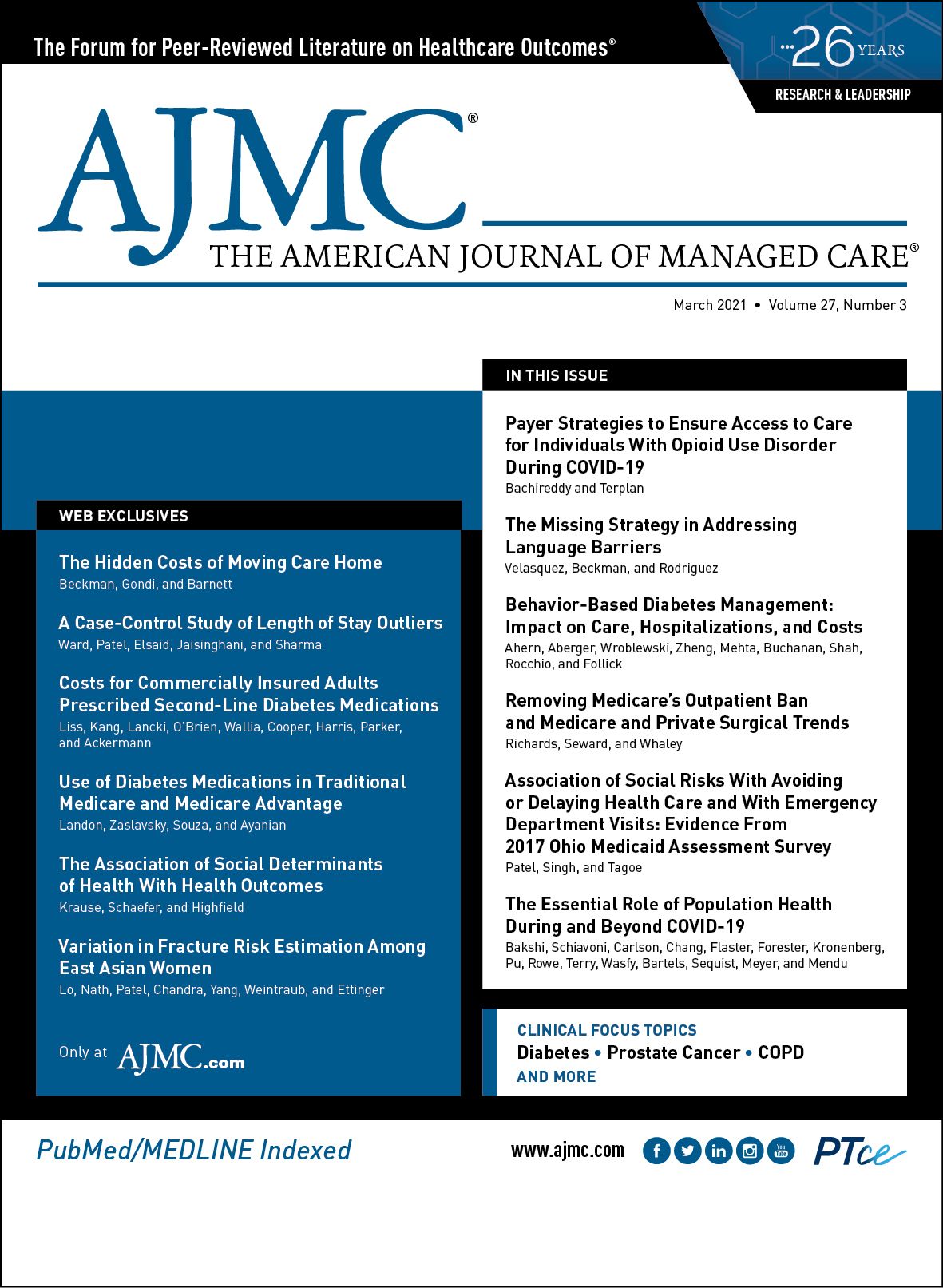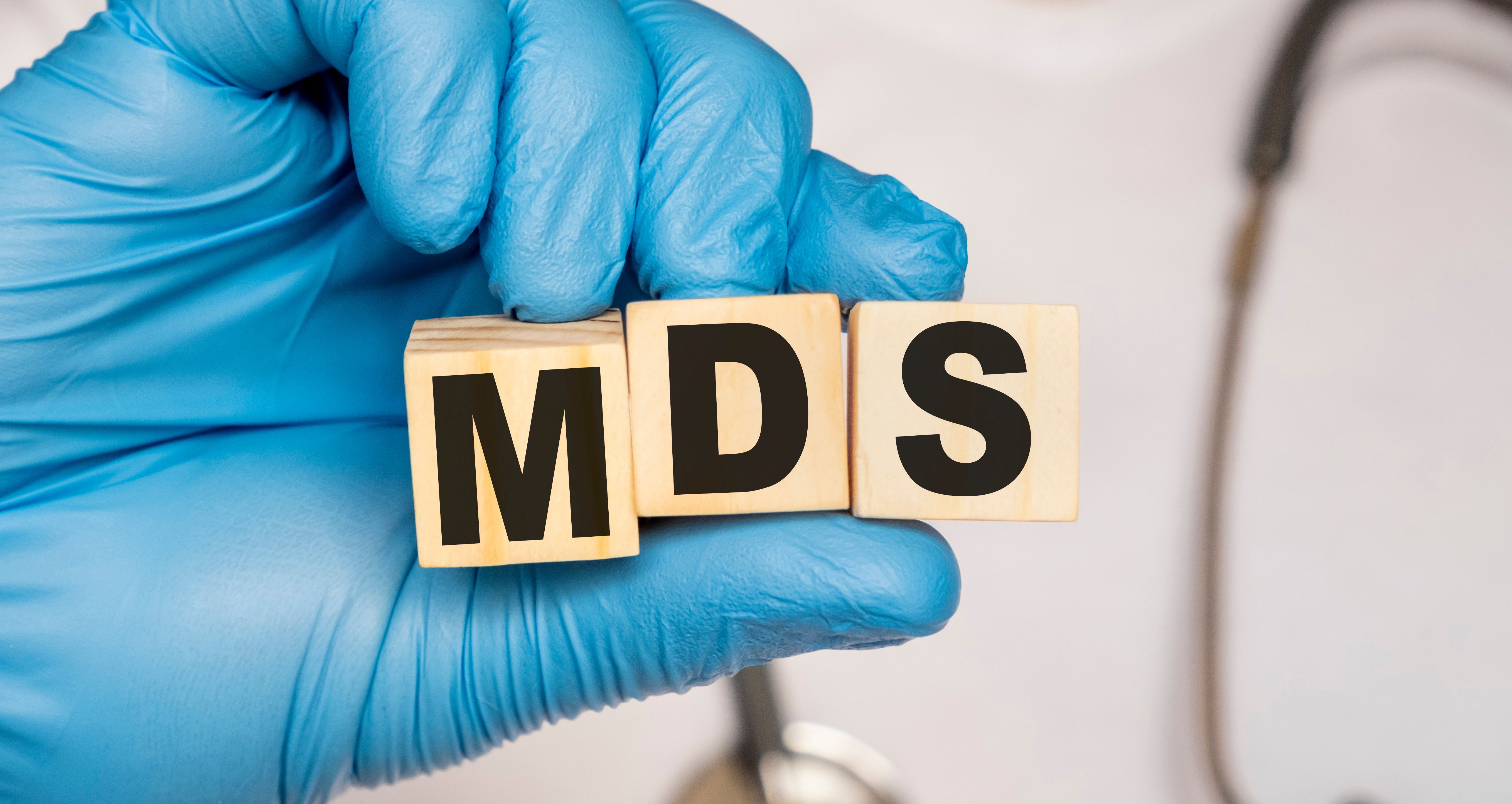Publication
Article
The American Journal of Managed Care
Variation in Fracture Risk Estimation Among East Asian Women
Author(s):
Fracture prediction tools for East Asian individuals vary by country. In the United States, the US-Asian Fracture Risk Assessment Tool provides hip fracture probabilities that correspond to observed estimates.
ABSTRACT
Objectives: Bone mineral density (BMD) testing and fracture risk calculation help clinicians assess fracture risk and counsel patients. However, predicted fracture risks and outcomes for US East Asian individuals remain understudied.
Study Design: Retrospective cohort study.
Methods: Using standardized clinical profiles for East Asian women aged 70 years, fracture probabilities were estimated using the US Fracture Risk Assessment Tool (FRAX) version 4.1 and corresponding FRAX tools for East Asian countries. Next, clinical and BMD data from 3785 US Asian women aged 65 to 74 years were used to estimate 10-year hip fracture risk (US-Asian FRAX-v3.1) in comparison with actual observed 10-year hip fracture risk (Kaplan-Meier product limit estimate).
Results: For the same patient profile entered in the US-Asian FRAX and country-specific FRAX, the calculated 10-year hip fracture probability varied. Compared with the US-Asian FRAX calculator, the estimate was 2-fold higher using the Taiwan FRAX and Hong Kong FRAX, somewhat higher using the South Korea FRAX and Japan FRAX, and similar using the China FRAX. Among 3785 US Asian women (mean [SD] age, 69 [3] years), 23 experienced a hip fracture during a median follow-up of 6.8 years. Their observed 10-year hip fracture risk was 1.5% (95% CI, 0.8%-2.7%), and their median (interquartile range) predicted fracture probability (US-Asian FRAX-v3.1) was 1.1% (0.6%-2.0%).
Conclusions: Country-specific FRAX estimates varied between the United States and East Asian countries. For US Asian women, the US FRAX–predicted hip fracture probabilities were in the lower range of observed risk. Although these findings support the use of the US-Asian FRAX for hip fracture risk assessment in US East Asian women, further studies are needed, including the examination of Asian subgroups.
Am J Manag Care. 2021;27(3):e97-e100. https://doi.org/10.37765/ajmc.2021.88604
Takeaway Points
Few studies address fracture risk prediction for US East Asian individuals, many of whom are immigrants.
- There is variation in the predicted risk of hip fracture for country-specific East Asia Fracture Risk Assessment Tool (FRAX) calculators and the US-Asian FRAX.
- Hip fracture outcome data among 3785 US Asian women with baseline bone density measurement and US-Asian FRAX–calculated fracture risk indicate that the predicted 10-year risk of hip fracture is within the lower range of the observed risk.
- These findings support use of the US-Asian FRAX for predicting hip fracture risk among US East Asian women, but further studies are needed, including the examination of Asian subgroups.
Over the past 2 decades, the US population has become increasingly diverse. By the year 2030, it is estimated that 53.8 million US residents will be foreign-born.1 Those of Asian race comprise a growing proportion of the aging immigrant population who remain understudied. For older women of Asian race, understanding and optimizing fracture risk assessment has become increasingly relevant, given their lower bone mineral density (BMD) and more likely diagnosis of osteoporosis2,3 but lower risk of fracture compared with their White counterparts.4-6 However, the evidence base for determining whether BMD treatment thresholds are the same for Asian individuals as they are for White individuals is lacking.
Within the United States, an important quality metric for fracture prevention care is osteoporosis screening through BMD assessment. Current guidelines from the US Preventive Services Task Force recommend BMD assessment for all women 65 years and older, as well as for younger postmenopausal women at increased risk for osteoporosis.7 Coupling clinical information with BMD, the Fracture Risk Assessment Tool (FRAX)8 estimates the 10-year probability of hip and major osteoporotic fractures to assist clinical decision-making, counseling, and management. To estimate fracture risk, US providers typically choose from 1 of 4 US FRAX calculators based on the patient’s race/ethnicity: US Caucasian, US Black, US Hispanic, and US Asian.8 A calibration factor is included in the US model for races/ethnicities other than non-Hispanic White; for US Asian women, this calibration factor is 0.5,9 based on the lower incidence of hip fracture for Asian women compared with White women from published epidemiologic observations among Asians residing in the United States.9-12 FRAX calculators developed for various East Asian countries are also available online,8 including for China, Hong Kong, Taiwan, Japan, and South Korea. However, for the same standardized patient profile, the results from these country-specific FRAX calculators can vary depending on the underlying fracture rate and mortality of the population, parameters that are incorporated in FRAX.13,14
One consideration for estimating fracture risk in immigrants is the suggestion that their country of origin’s FRAX might yield a more accurate fracture risk assessment.15 To examine potential differences that might be evident when calculating hip fracture probability for US East Asian immigrants by their country of origin’s FRAX, we first compared the results for the US-Asian FRAX calculator and results from various FRAX calculators of countries in East Asia for (hypothetical) standardized profiles of Asian women aged 70 years with osteopenia, focusing on the 10-year estimated risk of hip fracture. After observing large differences in these hypothetical FRAX estimates, we examined actual hip fracture outcome data from a historical cohort of similarly aged Northern California women identified as Asian at the time of BMD testing16,17 to compare their observed hip fracture risk with the estimates predicted by the US-Asian FRAX.
METHODS
We created a hypothetical profile of an East Asian woman, aged 70 years, who weighed 120 pounds, was 62 inches tall, and had a femoral neck (hip) BMD T-score of –2.0 and no other clinical risk factors. Using input data for this case scenario for the web-based FRAX calculator,8 we first estimated her 10-year probability of hip fracture using the US-Asian FRAX calculator and then the FRAX calculators for Japan, Korea, Taiwan, Hong Kong, and China. These countries and regions are likely places of origin for women of East Asian descent now residing in the United States. The standardized profile was also entered into the US-Caucasian FRAX and the Philippines FRAX. Additional calculations were performed to determine how the probabilities of hip fracture across countries would change for this hypothetical Asian woman when other clinical risk factors were added to the profile—specifically, having a prior fracture and 1 or 2 clinical risk factors. All FRAX calculations for these hypothetical cases were conducted online using FRAX version 4.1.8
In the second phase of this study, we used a previously developed retrospective cohort of Northern California women with BMD assessed in 1997-2003,2,16-18 without bisphosphonate treatment in the prior year, among whom hip fracture events were ascertained up to 2010.16-18 The subset of 3785 women with race/ethnicity identified as Asian (based on BMD race/ethnicity code “O”) who were aged 65 to 74 years at the time of BMD testing were included in these analyses. In addition to age, race, body mass index (BMI), and femoral neck BMD, the following FRAX input variables were derived from health plan ambulatory, hospitalization, and pharmacy databases as previously described16,17: oral glucocorticoid therapy, based on a cumulative prednisone dose equivalent of at least 1825 mg in the prior year; diagnoses of rheumatoid arthritis and conditions associated with secondary bone loss in the prior year; current smoking; and fracture within the prior 10 years after age 45 years (excluding fractures of the fingers, toes, face, and skull, and fractures associated with severe trauma). The 10-year probability of hip fracture was calculated using the US-Asian FRAX (version 3.1), with missing input parameters (eg, parental history, alcohol use) set to null or imputed (eg, population mean BMI, if missing), as previously described.16,17 Femoral neck BMD was classified based on BMD T-score19 calculated using Hologic National Health and Nutrition Examination Survey III peak BMD for young adult White women (0.849 ± 0.111 g/cm2),2,20 with osteoporosis defined by a BMD T-score of –2.5 and below and osteopenia by a BMD T-score between –1.0 and –2.5.21 Women were retrospectively followed up to 10 years or through December 2010, censoring at the first hip fracture event, membership termination, death, or receipt of a fourth prescription for an oral bisphosphonate drug (a treatment that could reduce fracture risk). Kaplan-Meier product limit estimates were used to determine the 10-year probability of hip fracture.16 In sensitivity analyses, we also examined these findings without censoring at the fourth bisphosphonate prescription. The study was approved by the Kaiser Permanente Northern California Institutional Review Board and a waiver of informed consent was obtained due to the nature of the study. Analyses were performed using SAS version 9.4 (SAS Institute).
RESULTS
When calculating the 10-year probability of hip fracture using FRAX for the hypothetical East Asian woman, aged 70 years, with osteopenia (T-score, –2.0), we observed the following differences based on the country-specific FRAX calculator used (Figure). The East Asian woman with no clinical risk factors had an estimated probability of hip fracture that was lowest based on the US-Asian FRAX (1.3%) and similarly low for the China FRAX (1.4%). Hip fracture FRAX probability estimates were somewhat higher for Japan (1.8%) and South Korea (2.2%), considerably higher for Hong Kong (2.6%), and yet higher for Taiwan (3.2%). The US-Asian FRAX estimate was nearly half that of the US-Caucasian FRAX estimate (2.3%), and the FRAX estimate was even lower for a (Filipina) woman in the Philippines (0.8%). Although 10-year hip fracture probability estimates changed with the addition of each additional risk factor (clinical factors and prior fracture) (Figure), the incremental change within each country’s FRAX was virtually the same and indicated that the FRAX tools of different countries likely weighed risk factors similarly. For these hypothetical case scenarios, the much higher hip fracture probability estimates using the Hong Kong or Taiwan FRAX tools approached or exceeded the US 3% treatment threshold (recommended by the National Osteoporosis Foundation)22,23 in contrast to the US-Asian FRAX. Note that Taiwan uses a higher 7% treatment threshold for hip fracture24 that offsets the higher calculated hip fracture probability.
We next examined the subset of 3785 Northern California Asian women who were aged 65 to 74 years at the time of BMD testing; the mean (SD) age of the cohort was 69 (3) years. Based on femoral neck BMD T-score (median T-score, –1.9), 53% and 27% of women met BMD criteria for osteopenia and osteoporosis, respectively. During a median (interquartile range [IQR]) follow-up of 6.8 (1.6-8.2) years, 23 experienced a hip fracture, resulting in a 10-year observed hip fracture probability of 1.5% (95% CI, 0.8%-2.7%). For this same cohort of 3785 women, the median (IQR) predicted 10-year risk of hip fracture based on the US-Asian FRAX (version 3.1) was similar, albeit slightly lower, at 1.1% (0.6%-2.0%).
In a sensitivity analysis, without censoring for bisphosphonate use (which affected 40.3% at some point during follow-up), there were a total of 41 hip fracture events among 3785 women during a median (IQR) follow-up of 8.0 (7.2-9.2) years, and the observed 10-year hip fracture probability was 1.6% (95% CI, 1.1%-2.5%).
DISCUSSION
Based on our examination of FRAX calculators from various countries across East Asia, we found that the 10-year estimated risk of hip fracture varied depending on the FRAX calculator used, consistent with previous observations.13,14 This report highlights the clinical relevance of these differences for clinicians providing care to ethnically diverse populations in the United States. Findings from our cohort of US Asian women demonstrate that the predicted hip fracture probabilities using the US Asian FRAX were within the lower range of the observed hip fracture risk.
Among first-generation US Asian immigrants, use of the FRAX tool developed for their country of origin might be considered. Based on the evidence that foreign-born adults in Sweden have a lower risk of fracture than native populations,15,25 FRAX experts have suggested that using a patient’s country-of-origin FRAX may be more appropriate for fracture risk assessment in Sweden.15 Hong Kong, Taiwan, and China are the 3 primary regions of origin for US naturalized Chinese Americans in California. However, this approach may be not be appropriate for East Asian immigrants from Hong Kong and Taiwan, where region-specific FRAX calculators yield 2-fold or higher estimates compared with the US-Asian FRAX. Our study indicates that the US-Asian FRAX calculation would be preferable for such women residing in the United States.
Limitations
Our study has some limitations, including the small size of our US Asian cohort, resulting in few observed hip fracture events, and the lack of Asian ethnic subgroup differentiation. However, the assignment of Asian race at BMD testing (1997-2003) favored identification of East and Southeast Asians, with Chinese as the largest Asian subgroup in our source cohort2; many were likely to be first-generation immigrants due to early US legislative limits on immigration from Asia prior to the 1950s.26 Our findings do not apply to US South Asians, minimally represented in our cohort,18 whom some feel have a fracture risk closer to US White women.27 Additionally, although bisphosphonate treatment might influence hip fracture risk, our sensitivity analysis indicates minimal difference with or without treatment censoring during follow-up. Further, we did not examine the probability of other osteoporotic fractures, such as vertebral fractures, which may be higher in East Asians.13 Finally, the clinical variables for FRAX input were derived from electronic health records, where missing values were imputed or set to null,16 resulting in potential underestimation of calculated fracture risk.
CONCLUSIONS
To avoid potential overtreatment of US East Asian women for hip fracture prevention, our initial observations suggest that providers caring for older US East Asian women can continue to rely on the US-Asian FRAX-Hip calculation (as provided in the BMD clinical report) rather than the country-of-origin FRAX, until more data are available. However, further research is needed, with a focus on US Asian subgroups where specific population fracture rates have not been well studied. Whether the US-Asian FRAX is more appropriate for predicting major osteoporotic fracture risk is less clear, because major osteoporotic fracture incidence data are largely lacking for both US Asians and Asian ethnicity subgroups. Consistent with the need for more ethnogeriatric research,5,28,29 future studies should examine fracture risk and outcomes for the different Asian ethnicities represented in the large and growing Asian diaspora within the United States.
Acknowledgments
The authors would like to thank Kate Michi Ettinger, JD, for her review and insightful comments on this paper.
Author Affiliations: Division of Research, Kaiser Permanente Northern California (JCL, MC, BE), Oakland, CA; Department of Medicine (JCL, SN, BY) and Department of Graduate Medical Education (MRW), Kaiser Permanente Oakland Medical Center, Oakland, CA; Department of Medicine, Kaiser Permanente Roseville Medical Center (MP), Roseville, CA.
Source of Funding: None.
Author Disclosures: The authors report no relationship or financial interest with any entity that would pose a conflict of interest with the subject matter of this article.
Authorship Information: Concept and design (JCL, SN, MP, MC, BE); acquisition of data (JCL, SN, MP, MC); analysis and interpretation of data (JCL, SN, MP, MC, BY, MRW, BE); drafting of the manuscript (JCL, SN, MP, BE); critical revision of the manuscript for important intellectual content (JCL, SN, MP, MC, BY, MRW, BE); statistical analysis (MC); provision of patients or study materials (JCL, SN, MP, MC); administrative, technical, or logistic support (JCL, MC, BY, MRW); and supervision (JCL).
Address Correspondence to: Joan C. Lo, MD, Division of Research, Kaiser Permanente Northern California, 2000 Broadway, Oakland, CA 94612. Email: Joan.C.Lo@kp.org.
REFERENCES
1. Vespa J, Medina L, Armstrong DM. Demographic turning points for the United States: population projections for 2020 to 2060. US Census Bureau Current Population Report No. P25-1144. March 2018. Updated February 2020. Accessed February 22, 2021. https://www.census.gov/content/dam/Census/library/publications/2020/demo/p25-1144.pdf
2. Lo JC, Kim S, Chandra M, Ettinger B. Applying ethnic-specific bone mineral density T-scores to Chinese women in the USA. Osteoporos Int. 2016;27(12):3477-3484. doi:10.1007/s00198-016-3673-9
3. Walker MD, Babbar R, Opotowsky AR, et al. A referent bone mineral density database for Chinese American women. Osteoporos Int. 2006;17(6):878-887. doi:10.1007/s00198-005-0059-9
4. Wright NC, Saag KG, Curtis JR, et al. Recent trends in hip fracture rates by race/ethnicity among older US adults. J Bone Miner Res. 2012;27(11):2325-2332. doi:10.1002/jbmr.1684
5. Lo JC, Ettinger B. How should we counsel Asian Americans about fracture risk? J Am Geriatr Soc. 2020;68(7):1613-1614. doi:10.1111/jgs.16444
6. Barrett-Connor E, Siris ES, Wehren LE, et al. Osteoporosis and fracture risk in women of different ethnic groups. J Bone Miner Res. 2005;20(2):185-194. doi:10.1359/JBMR.041007
7. Curry SJ, Krist AH, Owens DK, et al; US Preventive Services Task Force. Screening for osteoporosis to prevent fractures: US Preventive Services Task Force Recommendation Statement. JAMA. 2018;319(24):2521-2531. doi:10.1001/jama.2018.7498
8. Welcome to FRAX. University of Sheffield. Accessed January 1, 2020. https://www.sheffield.ac.uk/FRAX/
9. Dawson-Hughes B, Tosteson ANA, Melton LJ III, et al. Implications of absolute fracture risk assessment for osteoporosis practice guidelines in the USA. Osteoporos Int. 2008;19(4):449-458. doi:10.1007/s00198-008-0559-5
10. Lauderdale DS, Jacobsen SJ, Furner SE, Levy PS, Brody JA, Goldberg J. Hip fracture incidence among elderly Asian-American populations. Am J Epidemiol. 1997;146(6):502-509. doi:10.1093/oxfordjournals.aje.a009304
11. Silverman SL, Madison RE. Decreased incidence of hip fracture in Hispanics, Asians, and blacks: California Hospital Discharge Data. Am J Public Health. 1988;78(11):1482-1483. doi:10.2105/ajph.78.11.1482
12. Zingmond DS, Melton LJ III, Silverman SL. Increasing hip fracture incidence in California Hispanics, 1983 to 2000. Osteoporos Int. 2004;15(8):603-610. doi:10.1007/s00198-004-1592-7
13. Cheung EYN, Tan KCB, Cheung CL, Kung AWC. Osteoporosis in East Asia: current issues in assessment and management. Osteoporos Sarcopenia. 2016;2(3):118-133. doi:10.1016/j.afos.2016.07.001
14. Kanis JA, Odén A, McCloskey EV, Johansson H, Wahl DA, Cooper C; IOF Working Group on Epidemiology and Quality of Life. A systematic review of hip fracture incidence and probability of fracture worldwide. Osteoporos Int. 2012;23(9):2239-2256. doi:10.1007/s00198-012-1964-3
15. McCloskey EV, Harvey NC, Johansson H, Kanis JA. FRAX updates 2016. Curr Opin Rheumatol. 2016;28(4):433-441. doi:10.1097/BOR.0000000000000304
16. Lo JC, Pressman AR, Chandra M, Ettinger B. Fracture risk tool validation in an integrated healthcare delivery system. Am J Manag Care. 2011;17(3):188-194.
17. Pressman AR, Lo JC, Chandra M, Ettinger B. Methods for assessing fracture risk prediction models: experience with FRAX in a large integrated health care delivery system. J Clin Densitom. 2011;14(4):407-415. doi:10.1016/j.jocd.2011.06.006
18. Khandelwal S, Chandra M, Lo JC. Clinical characteristics, bone mineral density and non-vertebral osteoporotic fracture outcomes among post-menopausal U.S. South Asian women. Bone. 2012;51(6):1025-1028. doi:10.1016/j.bone.2012.08.118
19. Faulkner KG. The tale of the T-score: review and perspective. Osteoporos Int. 2005;16(4):347-352. doi:10.1007/s00198-004-1779-y
20. Bonnick SL. Bone Densitometry in Clinical Practice. 3rd ed. Humana Press; 2010.
21. Schousboe JT, Shepherd JA, Bilezikian JP, Baim S. Executive summary of the 2013 International Society for Clinical Densitometry Position Development Conference on bone densitometry. J Clin Densitom. 2013;16(4):455-466. doi:10.1016/j.jocd.2013.08.004
22. Tosteson AN, Melton LJ III, Dawson-Hughes B, et al; National Osteoporosis Foundation Guide Committee. Cost-effective osteoporosis treatment thresholds: the United States perspective. Osteoporos Int. 2008;19(4):437-447. doi:10.1007/s00198-007-0550-6
23. Cosman F, de Beur SJ, LeBoff MS, et al; National Osteoporosis Foundation. Clinician’s guide to prevention and treatment of osteoporosis. Osteoporos Int. 2014;25(10):2359-2381. doi:10.1007/s00198-014-2794-2
24. Chan DC, McCloskey EV, Chang CB, et al. Establishing and evaluating FRAX probability thresholds in Taiwan. J Formos Med Assoc. 2017;116(3):161-168. doi:10.1016/j.jfma.2016.03.006
25. Johansson H, Odén A, Lorentzon M, et al. Is the Swedish FRAX model appropriate for Swedish immigrants? Osteoporos Int. 2015;26(11):2617-2622. doi:10.1007/s00198-015-3180-4
26. Carlson AW. One century of foreign immigration to the United States: 1880-1979. Int Migr. 1985;23(3):309-334. doi:10.1111/j.1468-2435.1985.tb00322.x
27. Kuruvilla K, Kenny AM, Raisz LG, Kerstetter JE, Feinn RS, Rajan TV. Importance of bone mineral density measurements in evaluating fragility bone fracture risk in Asian Indian men. Osteoporos Int. 2011;22(1):217-221. doi:10.1007/s00198-010-1237-y
28. Yeo G, Yoshikawa T. To the future of ethnogeriatric research and publication. J Am Geriatr Soc. 2019;67(6):1120-1122. doi:10.1111/jgs.15875
29. American Geriatrics Society Ethnogeriatrics Committee. Achieving high-quality multicultural geriatric care. J Am Geriatr Soc. 2016;64(2):255-260. doi:10.1111/jgs.13924







